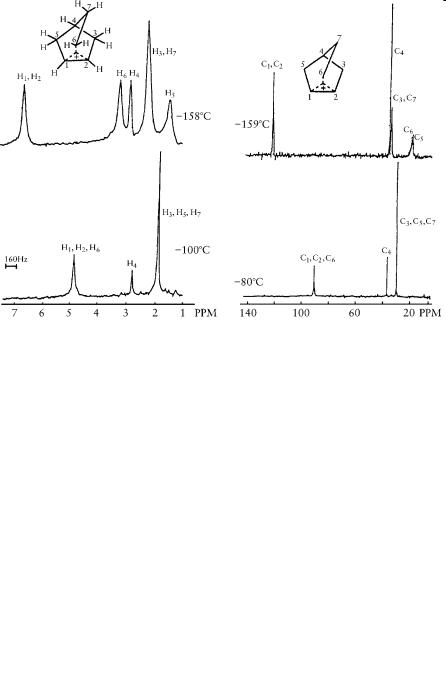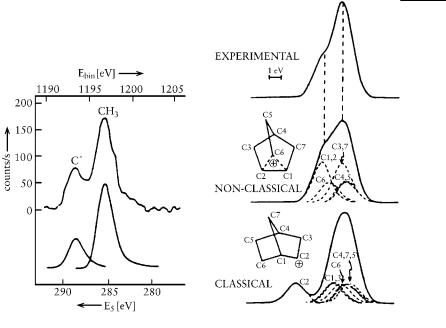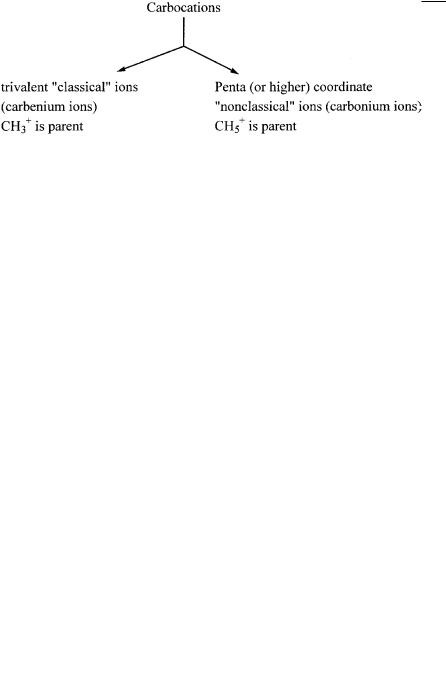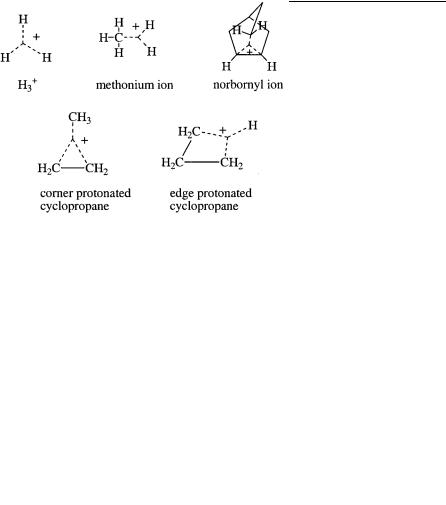
Olah G.A. - A Life of Magic Chemistry (2001)(en)
.pdf
140 A L I F E O F M A G I C C H E M I S T R Y
cause was only steric hindrance to the sterically hindered endo side involving rapidly equilibrating ‘‘classical’’ trivalent ions.
Nonclassical ions, a term first used by John Roberts (an outstanding Caltech chemist and pioneer in the field), were defined by Paul Bartlett of Harvard as containing too few electrons to allow a pair for each ‘‘bond’’; i.e., they must contain delocalized -electrons. This is where the question stood in the early 1960s. The structure of the intermediate 2-norbornyl ion could only be suggested indirectly from rate (kinetic) data and observation of stereochemistry; no direct observation or structural study was possible at the time.
My own involvement with the norbornyl ion controversy goes back to 1960–1962, when I succeeded in developing a general method of preparing and studying persistent (long-lived) alkyl cations (Chapter 6). Not unexpectedly, my interest extended to the study of various carbocations, including the controversial 2-norbornyl cation. Whereas previous investigators were able to study carbocations only indirectly (by kinetic and stereochemical studies), my newly discovered methods allowed their preparation and direct study as persistent (long-lived) species.
The 1962 Brookhaven Mechanism Conference, where I first reported on long-lived carbocations in public, is still clear in my mind. The scheduled ‘‘main event’’ of the meeting was the continuing debate between Saul Winstein and Herbert Brown on the classical or nonclassical nature of carbocations (or carbonium ions as they were still called at the time). It must have come as a surprise to them and to the audience that a young chemist from an industrial laboratory was invited to give a major conference lecture to report having obtained and studied stable, long-lived carbonium ions (i.e., carbocations) by the new method of using a highly acidic (superacidic) system. I remember being called aside separately during the conference by Winstein and Brown, both towering and dominating personalities of the time who cautioned me that a young man should be exceedingly careful in making such claims. Each pointed out that most probably I was wrong and could not have obtained long-lived carbonium ions. Just in case, however, my method turned out to be real, I was advised to obtain further evidence for the ‘‘nonclassical’’ or ‘‘classical’’ nature

T H E N O N C L A S S I C A L I O N C O N T R O V E R S Y 141
(depending on who was giving the advice) of the much-disputed 2- norbornyl cation.
Because my method indeed allowed me to prepare carbocations as long-lived species, clearly the opportunity was there to experimentally decide the question through direct observation of the ion. At the time of the Brookhaven conference I had already obtained the proton NMR spectrum of 2-norbornyl fluoride in SbF5, but only at room temperature, which displayed a single broad peak indicating complete equilibration through hydride shifts and Wagner-Meerwein rearrangement (well known in solvolysis reactions and related transformations of 2- norbornyl systems). However, my curiosity was aroused, and when I moved to Dow’s Eastern Research Laboratory in 1964, the work was further pursued in cooperation with Paul Schleyer from Princeton (who became a lifetime friend) and Martin Saunders from Yale. Using SO2 as solvent, we were able to lower the temperature of the solution to78 C, and we also prepared the ion by ionization of -cyclopenten- ylethyl fluoride or by protonation of nortricylene in FSO3H;SbF5/ SO2ClF. The three separate routes (representing -, - or bent -par- ticipation) gave the identical ion.
I still did not have suitable low-temperature instrumentation of my own to carry out the low-temperature NMR studies, but Martin Saunders at Yale did. Thus our samples now traveled the Massachusetts Turnpike from Boston to New Haven, where with Marty we were able to study solutions of the norbornyl cation at increasingly lower temperatures using his home-built variable-temperature NMR instrumentation housed in the basement of the old Yale chemistry building. We

142 A L I F E O F M A G I C C H E M I S T R Y
were able to obtain NMR spectra of the ion at 78 C, where the 3,2- hydride shift was frozen out. However, it took until 1969, after my move to Cleveland, to develop efficient low-temperature techniques using solvents such as SO2ClF and SO2F2. We were eventually able to obtain high-resolution 1H and 13C NMR spectra (using 13C-enriched precursor) of the 2-norbornyl cation down to 159 C. Both the 1,2,6 hydride shifts and the Wagner-Meerwein rearrangement were frozen out at such a low temperature, allowing us to observe the static, bridged ion, which I first reported at the Salt Lake City Organic Chemistry Symposium in 1969.
The differentiation of bridged nonclassical from rapidly equilibrating classical carbocations based on NMR spectroscopy was difficult because NMR is a relatively slow physical method. We addressed this question in our work using estimated NMR shifts of the two structurally differing ions in comparison with model systems. Later, this task
Figure 9.1. 395 MHz 1H NMR spectra of 2-norbornyl 50 MHz proton decoupled 13C NMR spectra cation in SbF5/SO2ClF/SO2F2 solution of 2-norbornyl cation (13C enriched) in SbF5/SO2ClF/SO2F2 solution.

T H E N O N C L A S S I C A L I O N C O N T R O V E R S Y 143
became greatly simplified and more precise by highly efficient theoretical methods such as IGLO and GIAO, allowing the calculation of NMR shifts of differing ions and comparison with experimental data. It is rewarding to see, however, that our results and conclusions stood up well against all the more recent advanced studies.
As mentioned, we also carried out IR studies (a fast vibrational spectroscopy) early in our work on carbocations. In our studies of the norbornyl cation we obtained Raman spectra as well, although at the time it was not possible to theoretically calculate the spectra. Comparison with model compounds (the 2-norbornyl system and nortricyclane, respectively) indicated the symmetrical, bridged nature of the ion. In recent years, Sunko and Schleyer were able, using the sincedeveloped Fourier transform-infrared (FT-IR) method, to obtain the spectrum of the norbornyl cation and to compare it with the theoretically calculated one. Again, it was rewarding that their data were in excellent accord with our earlier work.
Kai Siegbahn’s (Nobel Prize in physics, 1981) core electron spectroscopy (ESCA) was another fast physical method that we applied to further resolve the question of bridged versus rapidly equilibrating ions. We were able to study carbocations in the late 1960s by this method, adapting it to superacidic matrixes. George Mateescu and Louise Riemenschneider in my Cleveland laboratory set up the necessary methodology for obtaining the ESCA spectra of a number of carbocations, including the tert-butyl and the 2-norbornyl cation in SbF5- based superacidic matrixes. These studies again convincingly showed the nonclassical nature of the 2-norbornyl cation. No trivalent carbenium ion center characteristic of a ‘‘classical’’ ion, such as is the case for the tert-butyl cation, was observed in the ESCA spectrum on a time scale where no chemical equilibration process could have any effect. Subsequent ESCA studies by us (with Grunthaner’s laboratory at Caltech’s Jet Propulsion Laboratory) and by Dave Clark fully justified our previous results and conclusions. So did ever more advanced theoretical calculations.
Additional significant experimental studies were also carried out by others. Arnett reported valuable calorimetric studies. Saunders showed the absence of the deuterium isotopic perturbation of equilibrium ex-

144 A L I F E O F M A G I C C H E M I S T R Y
Figure 9.2. Carbon 1s photoelectron spectrum 1s core-hole-state spectra for the 2- norbornyl cation of tert-butyl cation and Clark’s simulated spectra for the classical and nonclassical ions.
pected for a classical equilibrating system. Myhre and Yannoni, at extremely low (5 K) temperature, were able to obtain solid-state 13C NMR spectra that still showed no indication of freezing out any equilibrating classical ions. The barrier at this temperature should be as low as 0.2 kcal/mol (the energy of a vibrational transition). Laube was able to carry out single crystal X-ray structural studies on substituted 2- norbornyl cations. Schleyer’s theoretical studies including IGLO and related calculation of NMR shifts and their comparison with experimental data contributed further to the understanding of the -bridged carbonium ion nature of the 2-norbornyl cation. The classical 2-nor- bornyl cation was not even found to be a higher-lying intermediate!
As the norbornyl ion controversy evolved, it became a highly public and frequently very personal and bitter public debate. Saul Winstein suddenly died in the fall of 1969, shortly after the Salt Lake City symposium. To my regret, I seemed to have inherited his role in repre-

T H E N O N C L A S S I C A L I O N C O N T R O V E R S Y 145
senting the bridged nonclassical ion concept in subsequent discussions. Although Brown frequently stated that he had not been given the opportunity to express his point of view in public debates, to my recollection, a number of these debates took place, including meetings at La Grand Motte (France), Bangor (UK), and Seattle, WA.
The 1983 Seattle American Chemical Society symposium was, in fact, the de facto ‘‘closing’’ of the long-running debate. Although in the heat of the debates some personal remarks were made on both sides (to my regret, as I expressed subsequently also), the experimental evidence at the time was so overwhelming that I concluded my presentation saying, ‘‘I don’t intend to do any more research on the matter. There is nothing further to be discussed. . . .’’ My lecture was subsequently published (with Prakash and Saunders) under the title ‘‘Conclusion of the Classical-Nonclassical Ion Controversy Based on the Structural Study of the 2-Norbornyl Cation’’ in an article in the Accounts of Chemical Research. In the same issue, Brown wrote, ‘‘The nonclassical theory is not necessarily wrong, but it has been too readily accepted’’ (an obvious understatement concerning the enormous amount of work carried out on the topic). In any case, I kept my promise and have not done further work in the field. The chemical community, and later even the Swedish Academy, accepted the closure
Before our controversy in 1965 with Herbert Brown and Heinz Staab in Heidelberg

146 A L I F E O F M A G I C C H E M I S T R Y
of the debate, mentioning inter alia in connection with my Nobel Prize the nonclassical norbornyl ion as one of the resolved carbocation structures.
This is the way the so-called nonclassical ion controversy ended. It basically centered on the question of whether the structure of carbocations, including rapidly equilibrating ‘‘classical’’ ions, can be depicted adequately by using only Lewis-type 2-electron 2-center covalent bonding or whether there are also bridged or -localized ions, whose structural depiction also necessitates 2-electron 3-center bonding, including higher-coordinate carbon. The result was a new understanding of the general bonding nature of carbon compounds as well as of the electron donor ability and reactivity of single bonds in saturated hydrocarbons and -bonded compounds in general.
Intensive, critical studies of a controversial topic also help to eliminate the possibility of errors. One of my favorite quotations is by George von Bekesy, a fellow Hungarian-born physicist who studied fundamental questions of the inner ear and hearing (Nobel Prize in medicine, 1961):
‘‘[One] way of dealing with errors is to have friends who are willing to spend the time necessary to carry out a critical examination of the experimental design beforehand and the results after the experiments have been completed. An even better way is to have an enemy. An enemy is willing to devote a vast amount of time and brain power to ferreting out errors both large and small, and this without any compensation. The trouble is that really capable enemies are scarce; most of them are only ordinary. Another trouble with enemies is that they sometimes develop into friends and lose a good deal of their zeal. It was in this way the writer lost his three best enemies. Everyone, not just scientists, need a few good enemies!’’
Clearly there was no lack of devoted adversaries (perhaps a more proper term than enemies) on both sides of the norbornyl ion controversy. It is to their credit that we today probably know more about the structure of carbocations, such as the norbornyl cation, than about most other chemical species. Their efforts also resulted not only in rigorous studies but also in the development or improvement of many techniques. Although many believe that too much effort was expended

T H E N O N C L A S S I C A L I O N C O N T R O V E R S Y 147
on the ‘‘futile’’ norbornyl ion controversy, I believe that it eventually resulted in significant insights and consequences to chemistry. It affected in a fundamental way our understanding of the chemical bonding of electron-deficient carbon compounds, extending Kekule´’s concept of the limiting ability of carbon to associate with no more than four other atoms of groups (see Chapter 10). An equally significant consequence of the norbornyl cation studies was my realization of the ability of saturated C-H and C-C single bonds to act as two-electron-donors towards strong electrophiles such as carbocations or other highly reactive reagents in superacidic systems, not only in intramolecular but also, as found subsequently, in intermolecular transformations and electrophilic reactions. The key for this reactivity lies in the ability to form two-electron three-center (2e-3c) bonds (familiar in boron and organometallic chemistry). The electrophilic chemistry of saturated hydrocarbons (including that of the parent methane) rapidly evolved based on the recognition of the concept and significance of hypercoordinated carbon, in short, hypercarbon, in chemistry (Chapter 10).
Once the direct observation of stable, long-lived carbocations generally in highly acidic (superacid) systems became possible, it led me to the recognition of the general concept of hydrocarbon cations, including the realization that five (and higher coordinate) carbocations are the key to electrophilic reactions at single bonds in saturated hydrocarbons (alkanes, cycloalkanes). in 1972, I offered a general definition of carbocations based on the realization that two distinct classes of carbocations exist (it seemed to be the logical name for all cations of carbon compounds, because the negative ions are called carbanions).
Trivalent {‘‘classical’’} carbenium ions contain an sp2-hybridized electron-deficient carbon atom, which tends to be planar in the absence of constraining skeletal rigidity or steric interference. The carbenium carbon contains six valence electrons; thus it is highly electron deficient. The structure of trivalent carbocations can always be adequately described by using only two-electron two-center bonds (Lewis valence bond structures). CH3 is the parent for trivalent ions.
Penta- (or higher) coordinate (‘‘nonclassical’’} carbonium ions contain five or (higher) coordinate carbon atoms. They cannot be described by two-electron two-center single bonds alone but also neces-

148 A L I F E O F M A G I C C H E M I S T R Y
sitate the use of two-electron three (or multi)-center bonding. The carbocation center always has eight valence electrons, but overall the carbonium ions are electron deficient because of the sharing of two electrons among three (or more) atoms. CH5 can be considered the parent for carbonium ions.
Lewis’ concept that a covalent chemical bond consists of a pair of electrons shared between two atoms is a cornerstone of structural chemistry. Chemists tend to brand compounds as anomalous whose structures cannot be depicted in terms of such valence bonds alone. Carbocations with too few electrons to allow a pair for each ‘‘bond’’ came to be referred to as ‘‘nonclassical,’’ a name first used by Roberts for the cyclopropylcarbinyl cation and adapted by Winstein for the norbornyl cation. The name is still used, even though it is now recognized that, like other compounds, they adopt the structures appropriate for the number of electrons they contain with two-electron twoor two-electron three (even multi)-center bonding, not unlike the bonding principle established by Lipscomb (Nobel Prize, 1976) for boron compounds. The prefixes ‘‘classical’’ and ‘‘nonclassical,’’ I believe, will gradually fade away as the general principles of bonding are recognized more widely.
Whereas the differentiation of trivalent carbenium and pentacoordinated carbonium ions serves a useful purpose in defining them as limiting cases, it should be clear that in carbocationic systems there always exist varying degrees of delocalization. This can involve participation by neighboring n-donor atoms, -donor groups, or -donor C-H or C-C bonds.
Concerning carbocations, previous usage named the trivalent, planar ions of the CH3 type carbonium ions. If the name is considered anal-

T H E N O N C L A S S I C A L I O N C O N T R O V E R S Y 149
ogous to other onium ions (ammonium, sulfonium, phosphonium ions), then it should relate to the higher-valency or coordination-state carbocations. These, however, clearly are not the trivalent, but the pentaor higher-coordinated, cations of the CH5 type. The earlier German and French literature, indeed, frequently used the ‘‘carbenium ion’’ naming for trivalent cations.
Trivalent carbenium ions are the key intermediates in electrophilic reactions of -donor unsaturated hydrocarbons. At the same time, pentacoordinated carbonium ions are the key to electrophilic reactions of-donor saturated hydrocarbons through the ability of C-H or C-C single bonds to participate in carbonium ion formation.
Some characteristic bonding natures in typical nonclassical ions are the following.
Expansion of the carbon octet via 3d orbital participation does not seem possible; there can be only eight valence electrons in the outer shell of carbon, a small first-row element. The valency of carbon cannot exceed four. Kekule´’s concept of the tetravalence of carbon in bonding terms represents attachment of four atoms (or groups) involving 2e-2c Lewis-type bonding. However, nothing prevents carbon from also participating in multicenter bonding involving 2e-3c (or multicenter) bonds (see further discussion in Chapter 10).
Whereas the differentiation of limiting trivalent and pentaor highercoordinate ions serves a useful purpose in establishing the significant differences between these ions, it must be emphasized that these rep-
